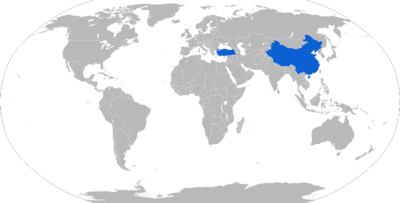B-611
| B-611 | |
|---|---|
| Type | Short-range ballistic missile |
| Place of origin | China |
| Service history | |
| Used by | China, Turkey |
| Production history | |
| Manufacturer | China Precision Machinery Import-Export Corporation |
| Specifications | |
|
| |
| Engine | solid fuel rocket motor |
| Propellant | Solid fuel |
Operational range | 150-480 km[1][2][3] |
The B-611 is a Chinese solid-fuelled short-range ballistic missile (SRBM) developed by China Precision Machinery Import-Export Corporation (CPMIEC).[4] The missile has a maximum range of 150-400 km.[5][2][3]
The B-611 development began development in 1995,[4] and first shown in 2004.[6] A newer variant was shown in late 2006.[4]
Variants
B611
Basic variant, with a range of 250-280 km and a 500 kg warhead.[1][8]
B611M
Upgraded variant of the B-611, with a 480 kg warhead and a range between 80-260 km.[9]
B611MR
The B611MR is a semi-ballistic surface-launched anti-radar missile first advertised in 2014. It uses GPS-inertial guidance and wideband passive radar. The missile is capable of flying flattened trajectory and performing pre-programmed maneuvers to reduce the chance of interception.[10]
P-12
The P-12 is a variant of the B-611. The P-12 has a longer cable, and is believed to be lighter than the B-611 and carry a 300 kg HE fragmentation or blast warhead.[4]
A pair of the missiles may be carried on a 6 x 6 wheeled vehicle.[4]
The P-12 was first shown at the 2006 China International Aviation & Aerospace Exhibition.[4]
BP-12
The BP-12 is a variant that has satellite guidance, and is considered the first member of the family to branch out from the B-611.[1]
BP-12A
The BP-12A is similar to the Type 631, with an estimated range of 300-400 km and a 480 kg warhead. The missile can be integrated into the SY-400 missile launcher.[2][3]
BP-12B
Latest variant, exhibited at the 2016 Zhuhai Airshow.[11][12]
SY-300
SY-300 is a development of WS-2/3, with SY standing for Shen Ying (神鹰 meaning Divine Eagle), designed after the 4th Academy and the 9th Academy of China Aerospace Science and Technology Corporation (CASC) were merged to form a new 4th Academy. The main difference between the SY300 and its WS-2/3 predecessor is that for WS-2/3, the control section of the forward control surfaces and the warhead are integrated into a single unit, but they are separated in SY-300. This design difference enables the guidance system of SY300 to be rapidly changed in the field by soldiers, by simply replacing the guidance system with a dummy weight, when SY-300 needs to be used as an unguided rocket.[13] Each vehicle can carry either six or twelve SY300 rockets.
SY-400
SY-400 is a further development of SY-300, that can carry either two short-range ballistic missiles BP-12A with range of 400km or twelve 400mm rockets.[14][15] As a low cost alternative to more expensive ballistic missiles, the accuracy of SY400 is increased by adding GPS to correct the cascade inertial navigational guidance, and according to the developer, the accuracy can be further improved if military grade GPS signals are used to replacing the existing civilian GPS signal. Another feature of SY-400 is that it shares the same launching vehicle and fire control system of BP-12A ballistic missile, thus simplifying logistics.[16][14]
Operators

Current operators
See also
References
- 1 2 3 Pike, John. "B-611 / BP-12A / Toros / Yildirim". Globalsecurity.org. Retrieved 3 August 2018.
- 1 2 3 "SY-400 Guided Rocket Makes TV Debut". Popsci.com. Retrieved 3 August 2018.
- 1 2 3 "Land Futures" (PDF). www.ausairpower.net. 2011.
- 1 2 3 4 5 6 Lennox, Duncan (18 December 2006). "China unveils B-611 short-range ballistic missile". Jane's. Archived from the original on 26 Feb 2008.
- 1 2 Wezeman, Pieter D. (July 2011). Conventional strategic military capabilities in the Middle East (PDF) (Report). EU Non-Proliferation Consortium. p. 10. Retrieved 29 October 2016.
- ↑ Lennox, Duncan (2009). "Project J (Yildirim, J-600T) (Turkey), Offensive weapons". Jane's. Archived from the original on 23 January 2013.
- ↑ Meick, Ethan (16 June 2014). China’s Reported Ballistic Missile Sale to Saudi Arabia: Background and Potential Implications (PDF) (Report). United States-China Economic and Security Review Commission. p. 3. Retrieved 29 October 2016.
- ↑ Sean, O'Connor, (31 August 2010). "PLA Ballistic Missiles". Ausairpower.net. Retrieved 3 August 2018.
- ↑ Administrator. "China presents latest technologies of air defense missile systems at IDET 2015 in Czech Republic 20051510 - IDET 2015 News Official Online Show Daily Coverage - Defence security military exhibition 2015". Armyrecognition.com. Retrieved 3 August 2018.
- ↑ Bill, Sweetman (12 Nov 2014). "New Weapons Unveiled At Airshow China". AviationWeek.com. Retrieved 30 October 2016.
- ↑ "留园网[美国]:海外华人的网络家园-海外中文第一站-6park.com". m.6park.com. Retrieved 3 August 2018.
- ↑ "News" (JPG). i.guancha.cn.
- ↑ "没能装备解放军的出口利器:SY300制导火箭炮". QQ.com (in Chinese). Tencent. 2012-11-16. Archived from the original on 2012-11-20. Retrieved 2012-11-23.
- 1 2 "SY-400 Guided Rocket Makes TV Debut". Popsci.com. Retrieved 3 August 2018.
- ↑ "Artillery: The Ballistic Missiles Of Arabia". Strategypage.com. Retrieved 3 August 2018.
- ↑ "[独家专访]SY400战术导弹最大射程180公里_网易新闻中心". War.163.com. 2010-11-19. Retrieved 2017-11-29.
- ↑ Ankit Panda. "Qatar Parades New Chinese Short-Range Ballistic Missile System". Thediplomat.com. Retrieved 3 August 2018.